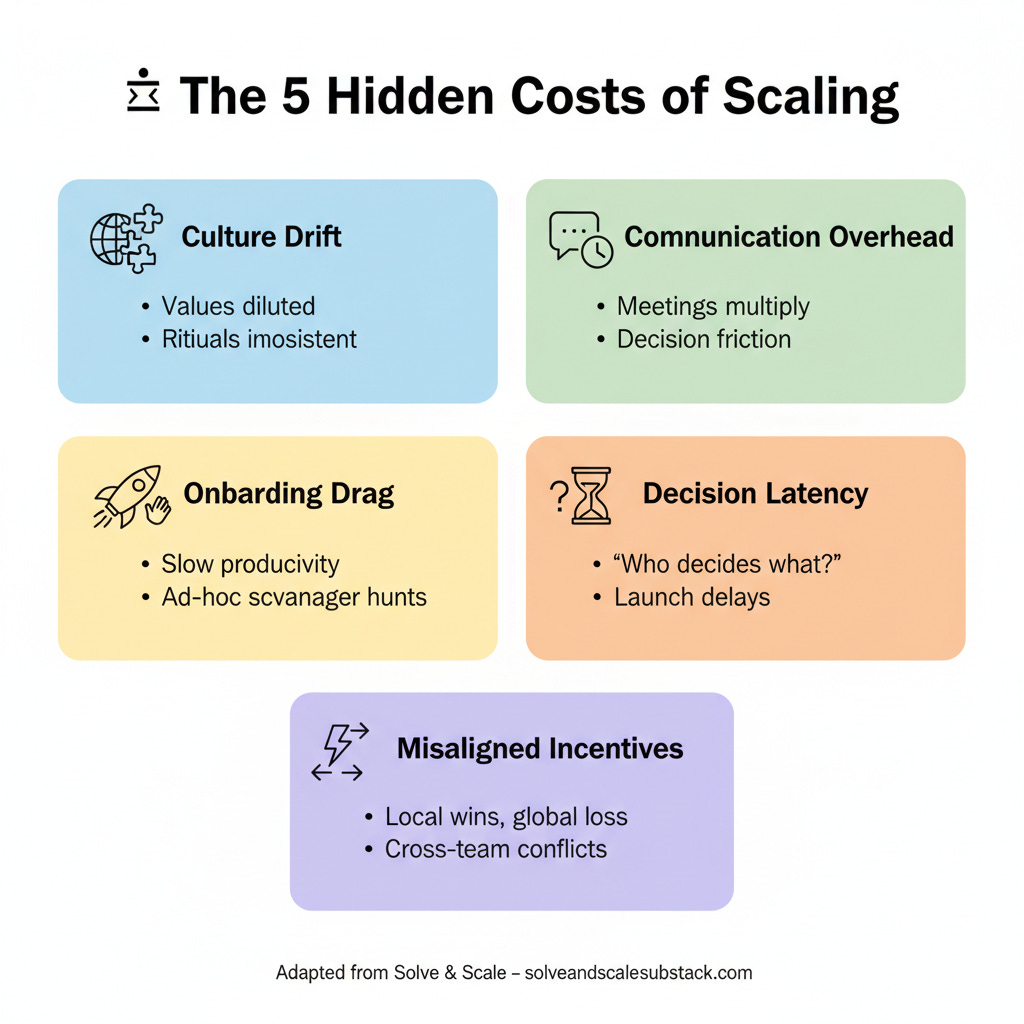Scaling Secrets: Why Growth Is Costing You Millions
The hidden organizational costs no one tells you about—and how to fix them fast.
I once audited a product org that had doubled headcount in nine months. Revenues were up, the roadmap was full, and the CEO began talking about market domination. Six months later, the team was six weeks behind every deadline, churn ticked upward, and a once-nimble release process felt like pouring concrete.
Nobody tracked “time to clarity” or “decision latency.” We only measured velocity and MAU. The invisible costs—those quiet frictions that multiply as organizations grow—had quietly eaten the margin the company thought it had earned.
Scaling isn’t just about multiplication. It’s about compounding. Each new person, each new feature, each new line of code carries a hidden tax. When we don’t budget for those taxes, they show up as missed launches, disengaged teams, and burned-out leaders.
This essay aims to make invisible costs visible. Once you have seen them, you can measure them, discuss them with your board, and design interventions that reduce—not amplify—the burden of scale.
The Five Hidden Costs of Scaling
Think of these as the “dark matter” of product leadership: you can’t see them directly, but you can measure their gravitational pull.
1. Culture Drift
When you’re 10 people in a room, everyone knows “how things are done here.” At 100 people across three time zones, rituals get diluted. Values become slogans, not behaviors. Culture drifts unless actively stewarded.
Signal: inconsistent decision-making across teams, wildly different onboarding experiences, or new hires confused about “what’s normal here.”
2. Communication Overhead
Each new reporting line or Slack channel adds nodes to the network. The cost of coordination grows quadratically, not linearly. Suddenly, decisions require six meetings, and a once-tight roadmap discussion balloons into 20 threads.
Signal: meeting sprawl, long email chains with “cc: everyone,” or leaders who spend more time updating each other than leading teams.
3. Onboarding Drag
New hires don’t become productive just because they get a laptop. They need context, relationships, and clarity. Without a scaled onboarding system, onboarding becomes an ad-hoc scavenger hunt—and productivity lags.
Signal: engineers still “getting up to speed” at Day 90, new PMs unsure of decision rights, duplicate work created by fresh hires.
4. Decision Latency
As companies grow, the time it takes to make a decision stretches. Decisions are delayed not because they’re complex, but because nobody knows who makes the decisions.
Signal: projects stall waiting for sign-off, product launches slip due to re-reviews, and people ask “who owns this?” more often than they execute.
5. Misaligned Incentives
When marketing, sales, product, and engineering optimize for their own OKRs, they create local wins at the expense of global outcomes. Scaling multiplies those silos unless you actively bridge them.
Signal: features shipped that don’t align with sales promises, engineering optimizing for tech debt reduction while product optimizes for speed, or cross-functional teams in quiet conflict.
A Simple Model: Putting Numbers to the Invisible
Most leaders shy away from quantifying hidden costs because it feels fuzzy. But you don’t need perfect precision—you just need a way to make the invisible legible.
Here’s a lightweight spreadsheet model you can adapt:
Keep reading with a 7-day free trial
Subscribe to Solve & Scale to keep reading this post and get 7 days of free access to the full post archives.



